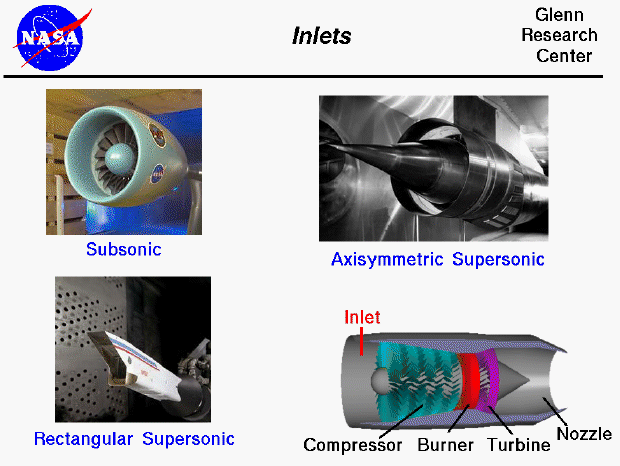

Most modern passenger and military aircraft are powered by gas turbine engines, which are also called jet engines. There are several different types of gas turbine engines, but all turbine engines have some parts in common. All turbine engines have an inlet to bring free stream air into the engine. The inlet sits upstream of the compressor and, while the inlet does no work on the flow, there are some important design features of the inlet as described on a separate slide. As shown in the figures above, inlets come in a variety of shapes and sizes with the specifics usually dictated by the speed of the aircraft.
SUBSONIC INLETS
For aircraft that cannot go faster than the speed of sound (like large airliners), a simple, straight, short inlet works quite well. On a typical subsonic inlet, the surface of the inlet, from outside to inside, is a continuous smooth curve with some thickness from inside to outside. The very front (most upstream portion) of the inlet is called the highlight, or the inlet lip. A subsonic aircraft has an inlet with a relatively thick lip.
SUPERSONIC INLETS
An inlet for a supersonic aircraft, on the other hand, has a relatively sharp lip. The inlet lip is sharpened to minimize the performance losses from shock waves that occur during supersonic flight. For a supersonic aircraft, the inlet must slow the flow down to subsonic speeds before the air reaches the compressor. Some supersonic inlets, like the one at the upper right, use a central cone to shock the flow down to subsonic speeds. Other inlets, like the one shown at the lower left, use flat hinged plates to generate the compression shocks, with the resulting inlet geometry having a rectangular cross section. This kind of inlet is seen on the F-14 and F-15 fighter aircraft. There are other, more exotic inlet shapes used on some aircraft for a variety of reasons.
INLET EFFICIENCY
An inlet must operate efficiently over the entire flight envelope of the aircraft. At very low aircraft speeds, or when just sitting on the runway, free stream air is pulled into the engine by the compressor. In England, inlets are called intakes, which is a more accurate description of their function at low aircraft speeds. At high speeds, a good inlet will allow the aircraft to maneuver to high angles of attack and sideslip without disrupting flow to the compressor. Because the inlet is so important to overall aircraft operation, it is usually designed and tested by the airframe company, not the engine manufacturer. But because inlet operation is so important to engine performance, all engine manufacturers also employ inlet aerodynamicists.
Go to...
byTom
Benson
Please send suggestions/corrections to: benson@grc.nasa.gov